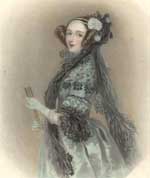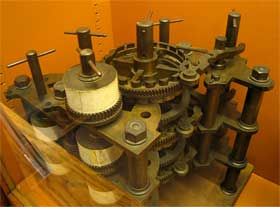Why The Computer Was Invented
For centuries, humans have needed help in calculating. Making trade transactions, taking a population census, or figuring out the distance between two stars takes tons of calculating. And if you want an accurate result, no mistakes are allowed.
The earliest calculator was the human hand and its fingers. When quantities larger than fingers needed counting, various natural items like pebbles and twigs were used.
The abacus was one of many counting devices invented to help count large numbers.
|
A Chinese abacus |
There is a difference between counting boards and abaci. The counting board is a piece of wood, stone or metal with carved grooves or painted lines. Beads, pebbles or metal discs were moved between the lines or grooves to count. The abacus is a device of wood or plastic with a frame that holds rods with freely-sliding beads mounted on them.
Both the abacus and the counting board are mechanical aids used for counting. They are not what we think of as a modern calculators. The person operating the abacus performs calculations in his head and uses the abacus as a physical aid to keep track of the sums. Some tradesmen still use them nowadays to make their calculations on the markets in Asia, for example.
Mechanical Machines
|
© Musée des arts et métiers/S. Pelly A calculating machine invented by Blaise Pascal in 1645. |
In the 17th century, mechanical machines were invented for counting. But these machines were not very practical to use.
Blaise Pascal invented the first calculating machine. Credited with founding the modern theory of probability, he also discovered the properties of the cycloid (or roulette) and contributed to the advance of differential calculus. As a physicist, his failed attempts to discredit the notion that 'nature abhors a vacuum' led to the invention of the barometer, hydraulic press and syringe. The SI unit (International System of units) of pressure, the Pascal, and a computer programming language are named after him.
|
Blaise Pascal (1623-1662), inventor of the first calculating machine |
Charles Babbage (December 26, 1791 – October 18, 1871) was an English mathematician, analytical philosopher and (proto-) computer scientist who was the first person to come up with the idea of a programmable computer. |
Ada Lovelace (December 10, 1815 - November 27, 1852) |
A Protean Computer
|
This is part of Charles Babbage's Difference Engine, assembled after his death by Babbage's son, using parts found in his laboratory |
It was a scientist in the 19th century, Charles Babbage, who had the idea of a machine which could be programmed like a computer. But the machine, called the Difference Engine, was so complex that it was not possible for him to manufacture it with the mechanical technologies of the time. It had to wait until 1991 when it was finally built as envisaged by Babbage’s plans! Of course, it wasn’t useful anymore since a much more powerful calculator—the computer—had been invented. None of the three computing machines designed by Babbage—the two Difference Engines and the Analytical Engine—were fully constructed during his lifetime.
Also known as Lady Lovelace, Augusta Ada King, Countess of Lovelace, is considered the first computer programmer. She wrote a description of Babbage's early mechanical general-purpose computer, the analytical engine, which he designed after the Difference Engine.
With the article, she appended a set of notes which specified in complete detail a method for calculating Bernoulli numbers with the Engine. These notes are recognized by historians as the world's first computer program. She also speculated that "the Engine might compose elaborate and scientific pieces of music of any degree of complexity or extent." This is part of Charles Babbage's Difference Engine, assembled after his death by Babbage's son, using parts found in his laboratory.
In 1991, working from Babbage's original plans, the London Science Museum constructed a Difference Engine, which functioned perfectly.
This content has been re-published with permission from SEED. Copyright © 2025 Schlumberger Excellence in Education Development (SEED), Inc.







